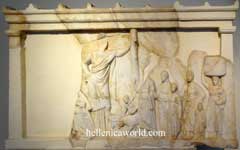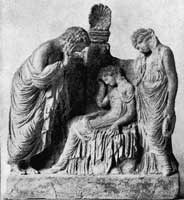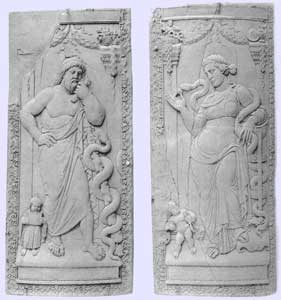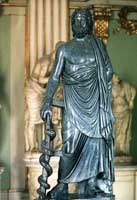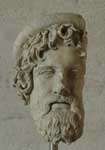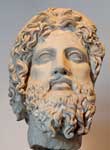.
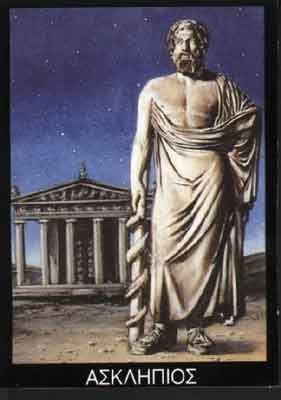
Asklepios, a mythical person, the son of Apollo and Coronis. His teacher of medicine was Chiron the centaur (also a teacher of Achilles)
Asklepios, or Asclepius (Ἀσκληπιός, Ασκληπιός) (or in Roman Aesculapius), god of medicine and healing in ancient Greek mythology, according to which he was born a mortal but was given immortality as the constellation Ophiuchus after his death. His name means "cut up".
Coronis (or Arsinoe) became pregnant with Asclepius by Apollo but fell in love with Ischys, son of Elatus. A crow informed Apollo of the affair and he sent his sister, Artemis, to kill Coronis. Her body was burned on a funeral pyre, staining the white feathers of the crows permanently black. Apollo rescued the baby though and gave it to the centaur Chiron to raise. Phlegyas, Coronis' father, was irate and torched the Apollonian temple at Delphi and Apollo killed him.
Chiron taught Asclepius the art of surgery, teaching him to be the most well-respected doctor of his day. According to the Pythian Odes of Pindar, Chiron also taught him the use of drugs, incantations and love potions. In The Library, Apollodorus claimed that Athena gave him a vial of blood from the Gorgons. Gorgon blood had magical properties: if taken from the left side of the Gorgon, it was a fatal poison; from the right side, the blood was capable of bringing the dead back to life.
Asclepius was killed from a thunderbolt from Zeus. The exact reason varies but it was definitely punishment for violating the natural order of the world by bringing the dead back to life. According to some, the catalyst was his acceptance of money in exchange for resurrection. In others, Zeus killed him after Athena asked him to resurrect Hippolytus. Zeus killed Asclepius and, in some versions, re-killed Hippolytus.
When Zeus killed Asclepius for raising the dead and violating the natural order of things, Apollo killed the Cyclopes in response. They had fashioned Zeus' thunderbolts, which he used to kill Apollo's son, Asclepius.
Zeus placed Asclepius in the sky as the constellation Ophiuchus ("serpent-bearer").
During the Trojan War, Asclepius was on the side of the Greeks. He healed Philoctetes from a snake-bite.
In honor of Asclepius, snakes were often used in healing rituals. Non-poisonous snakes were left to crawl on the floor in dormitories where the sick and injured slept. Starting about 300 BC, the cult of Asclepius grew very popular. His healing temples were called asclepieion; pilgrims flocked to them to be healed. They slept overnight and reported their dreams to a priest the following day. He prescribed a cure, often a visit to the baths or a gymnasium.
Hippocrates, the legendary doctor, may have begun his career at an asclepieion on the island of Cos.

1333 : Asklepios, Votive relief in the shape of a temple. Pentelic
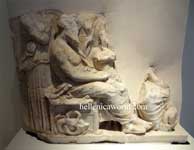
1352 : Asklepios, Panakeia, Iaso, Akeso, Epione and Ianiskos. Votive relief. Pentelic marble.
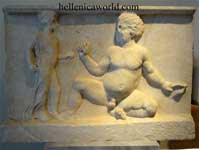
1424 : Asklepios Plaque with a relief scene. Marble
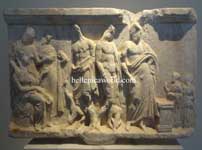
1426 : Asklepios, Machaon and Podaleirios, Votive relief. Marble.

A Patient and his family ask help from Asclepius and his family (here five of his children)
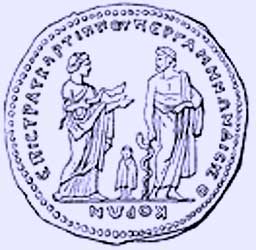
Aclepius with Hygeia and Telesforos, Marc Aurel Coins, Pergamon
Asclepius was married to Salus (or Epione) and with her fathered five daughters: Aceso, Iaso, Panacea, Aglaea and Hygieia, and three sons: Machaon, Telesforos and Podalirius. His most famous sanctuary was in Epidaurus in Northeastern Peloponnese.
His attributes included the rod of Asclepius and the cock.
Socrates' last words as reported in Plato's Phaedo are a reminder to Crito to sacrifice a cock for him to Asclepius.
(Φιλόλαος), that is, friend of the people, was a surname of Asclepius, under which he had a temple in Laconia (Pausanias iii. 22. § 7).
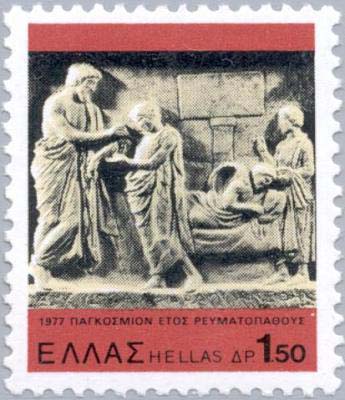
Votive relief of Archinos (370 BC) from Tyrea, Argolis (Oropos / Amphiaraus), 0.49 m x 0.55 m. The healing god Asklepios appears to the dreamer to cure him. National Archaeological Museum, Athens, No. 3369. The same person is shown 3 times. First Asklepios personally checks his hand. As a patient on a bed (kline) he is biten by a snake. Raising his hand he thanks Asklepios for the cure. Ancient Greece Medical Stamps
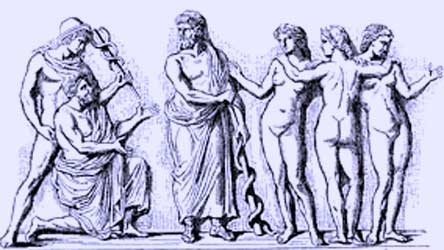
Hermes, Asclepius and the Graces, Relief, Pio Clementin Museum

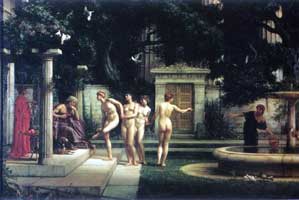
A Visit to Aesculapius, Sir Edward Poynter
Dream of Aesculapius, Sebastiano Ricci
A Sick Child brought into the Temple of Aesculapius, John William Waterhouse, 1877
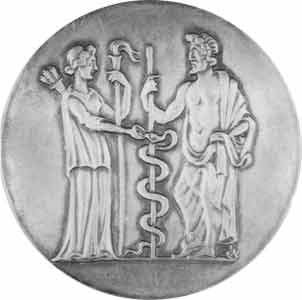
Asklepios Medal, Asklepios Prize since 1984, University of Saarland /Germany, with Asklepios and Artemis (derived from a coin from Pergamon)
Asclepieion Park of Athens, The first pilot application of a Modern Asclepieion
See also : Greek Mythology. Paintings, Drawings
| Ancient Greece
Science, Technology , Medicine , Warfare, , Biographies , Life , Cities/Places/Maps , Arts , Literature , Philosophy ,Olympics, Mythology , History , Images Medieval Greece / Byzantine Empire Science, Technology, Arts, , Warfare , Literature, Biographies, Icons, History Modern Greece Cities, Islands, Regions, Fauna/Flora ,Biographies , History , Warfare, Science/Technology, Literature, Music , Arts , Film/Actors , Sport , Fashion --- |
Retrieved from "http://en.wikipedia.org"
All text is available under the terms of the GNU Free Documentation License


